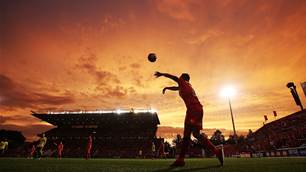Summer football may now be a regular part of the Australian sporting landscape, but Melbourne City Head Coach Erick Mombaerts isn’t a fan.
With football matches around Australia already being forced to contend with bushfire smoke from major burns across the country in 2019/20, the effects of the unprecedented heatwave buffeting the nation has also begun to take its toll.
On Wednesday, Australia recorded its hottest day in recorded history as maximum highs around the country averaged 41.9 degrees. That record broke the previous record that had been set on Tuesday by one degree.
Nullarbor in South Australia recorded a 49.9-degree temperature, setting the unwanted record for the hottest December day on record.
As climate change continues to worsen around the globe, such circumstances will, unfortunately, increasingly face sporting organisations that stage their events in the summer.
“I do think that as climate change continues to bite over the next few decades, sporting bodies are going to have to look at changing the timing of events that are commonly held in summer,” the Climate Council's Lesley Hughes told The Guardian earlier this year.
Originally scheduled for Friday afternoon, the W-League meeting between Melbourne Victory and Brisbane Roar at Melbourne’s Epping Stadium was postponed to Saturday morning in the face of a forecast ambient temperature of 42.6 degrees at kick-off.
One of their games already moved in the wake of smoke-driven air quality concerns, forecast extreme heat forced Central Coast Mariners Y-League fixture against Canberra United to be moved forward from 10:30 to 9:00 in an attempt to beat the heat.
Further afield, New Zealand’s cricket team was forced to abandon the opening day of a warm-up fixture for the Boxing Day test due to the conditions, while race meetings across the country were also called off.
More conservative than FIFA’s current heat policy, the FFA heat procedure states that a match may be delayed or postponed when the Wet Bulb Globe Temperature (WBGT) reaches 28 degrees.
Drinks breaks are to be provided at the halfway point of each half when the WBGT is measured between 26 and 27.9 degrees, or the temperature is 31 degrees or greater.
WBGT is a measure of the heat stress in direct sunlight that incorporates temperature, humidity, wind speed, sun angle, time of day and cloud cover into its measurement.
But, with Melbourne beginning to properly experience the heatwave that has already blasted the rest of Australia, Mombaerts got his first taste of how difficult operating under the harsh Australian sun can be outside of game days in recent days.
And, despite Saturday’s forecast for the Christmas Derby sitting in the high teens, he isn’t a fan of the concept of playing football in the heat.
“I’m very happy for the game [being cooler] and very happy also for my players,” he said at an outdoor press conference on Friday. “We played the Brisbane game where it was crazy, too humid and too hot.
“We want to play a high intensity so it was difficult to do. Because the player said we are tired, and we say you have to run more.
“I have to say, soccer is a winter sport. Yes. It’s very difficult to play in summer. It's very difficult.
“Why? Because you have to run more than 12km and it’s difficult to run when it’s 40 degrees. And also, it’s about the health of the player.
“Yes, we have to adapt, so we train earlier in the morning but also if we have to play one game at a hot temperature, I’m not happy with this. I’m not happy with this.
“You can’t run! If you can’t run. It's not good for spectators and fans, because the play is low, low level. Low level, low level!
“I don’t like this.
“I like when the ball is moving faster, when the players move faster and when they can play intensely. Yes, I don’t like this. If not, I sit on my bench, but I don’t like this.”
Related Articles

Leckie seals new marquee deal as Good, Maclaren head to Asia

Contentious 'Caceres Clause' to be phased out of ALM












